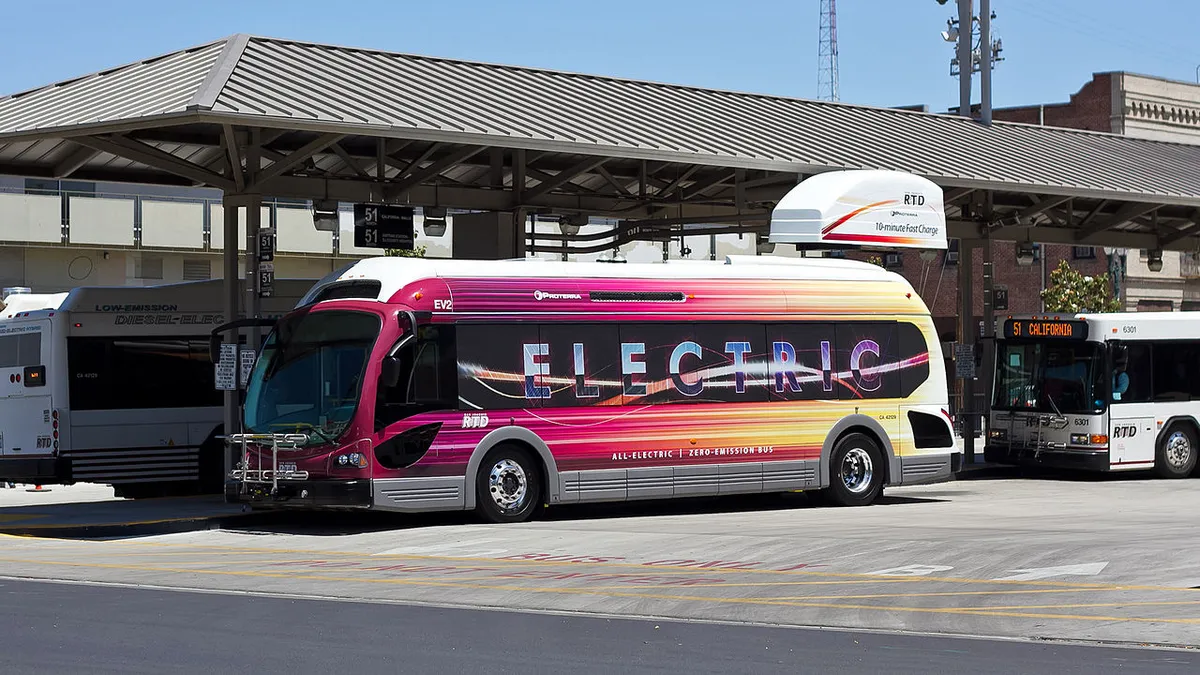Dive Brief:
- Southern California Edison (SCE) on Monday rolled out a program designed to advance the electrification of medium- and heavy-duty vehicles, including buses and tractor trailers, by offering to install infrastructure to support charging stations at no charge.
- Rebates for charging station equipment will also be available to some customers as well, including transit agencies and school bus operators. The program has a budget of about $356 million.
- The Charge Ready Transport program will fund installations at 870 commercial customer sites over a five-year period, which the utility anticipates will support at least 8,490 fleet vehicles. California regulators approved the plan last year.
Dive Insight:
SCE officials said they already had three applications submitted for the Charge Ready Transport program after announcing it in the morning. Charge Ready is one more piece of the decarbonization puzzle for the utility, to improve air quality and reduce carbon emissions in Southern California.
"We've been supporting vehicle electrification for quite a few years," Katie Sloan, SCE's director of eMobility, told Utility Dive.
Edison launched a Charge Ready pilot program for light duty vehicles a few years ago, and Sloan says it has installed about 1,000 ports. But "medium- and heavy-duty vehicles contribute quite a lot of pollution that impacts air quality in southern California," she added.
The region has some of the worst air quality in the nation.
SCE offers customers interested in the Charge Ready Transport program two options: the utility can handle the make-ready design and construction, or the customer can do it and claim an 80% rebate on the work. "We don't have a preference" regarding which option they choose, said Sloan. "We just want to facilitate the most electric adoption."
The program requires a 10-year right-of-way for SCE to access charging infrastructure, and participants will need to commit to purchasing at least two electric vehicles — though the Charge Ready Transport models anticipate about 10 vehicles per location.
Vehicles supported by the program include medium- and heavy-duty vehicles like step vans and tractor trailers, school and transit buses, forklifts and airport ground support equipment.
"I think we'll see a wide variation in this program, including customers that are smaller businesses, and may only have a couple of EVs," Sloan said. Customers will be able to access new time-of-use rates designed for electric vehicles, which mean no demand charges until 2024 — and then a slow phase-in of the charges through 2029.
While residential customers who install charging equipment through the Charge Ready program are required to participate in demand response programs, there is no such requirement for commercial entities. The utility is looking to its time-of-use rates to push charging to times when there is ample renewable energy on the system.
Jesse Lund, an associate at the Rocky Mountain Institute who focuses on electrification, spoke at SCE's kickoff event on Monday and discussed how customers going electric could save the most money. The process is lengthy, she cautioned, and includes more than simply buying electric vehicles and installing chargers.
"This is going to be a very time-intensive planning process," she said. "Looking about a year ahead is a good starting timeframe. Also, look at your vehicle acquisition plans over the next 10 years."
Despite a need to electrify long-distance freight hauling, Lund said RMI expects intra-city vehicles to be electrified first. And it will be the software networking capabilities of stations able to charge fleets at optimal times and interact with the utility grid that are "really going to allow you to have the best cost savings and the best chance of success with electrification of your fleet," she said.
SCE says it will now engage with more customers about the program and review applications. It will launch initial site inspections in the coming weeks and months. The utility has said the electrification program is "believed to be the largest of its kind in the nation," and industry observers say that is likely true.
SCE's latest program is "a very large and serious commitment to electrification of freight," Joel Levin, executive director of Plug In America, said in a statement to Utility Dive.
"Electrification of heavy duty transportation and freight in particular, is a critical piece of the overall puzzle," Levin said. "We cannot achieve our climate goals without it. The technology is not nearly as advanced as for cars, but it is moving forward now very rapidly."
Heavy duty electrification is "in roughly the same place" that light duty was in just a decade ago, Levin said, though he added that from an air-quality perspective, heavy-duty vehicles are more important.
"Trucks are responsible for much of our air pollution, especially in urban areas near ports and other transportation hubs," he said.















